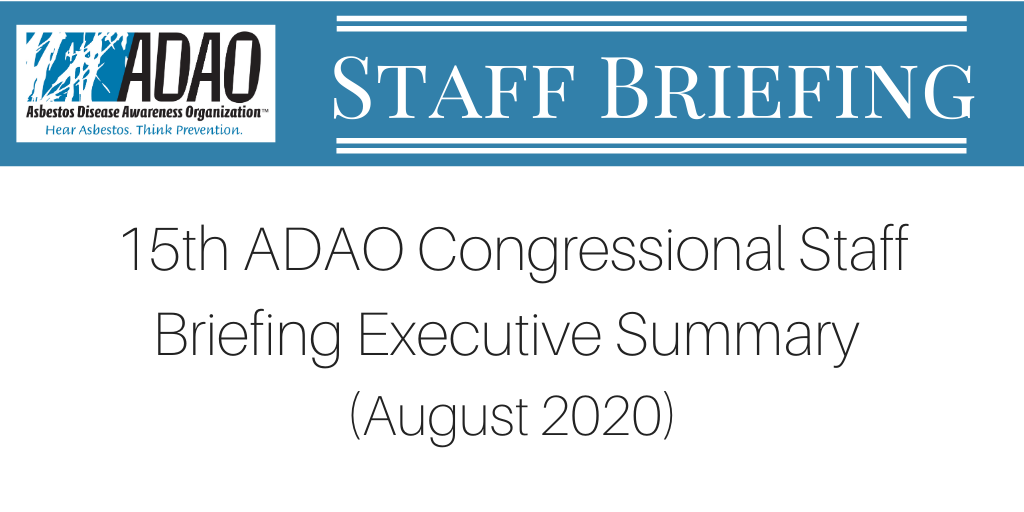15th ADAO Congressional Staff Briefing Executive Summary (August 2020)
Barry Castleman, ScD, Environmental Consultant:
- Nearly 70 countries have banned asbestos.
- In 2019, an estimated 170 metric tons of raw asbestos was imported from Russia for the chlor-alkali industry, the sole user of raw asbestos.
- The chlor-alkali industry can replace asbestos with more efficient diaphragm technology that pays for itself in 4 years.
Lindsay Dahl, Beautycounter 
- Beautycounter has been advocating for cosmetic reform in DC and state legislatures since 2013. We have been troubled by continued reports of asbestos-contaminated cosmetics appearing on store shelves which are often targeted to children and teens.
- Without an asbestos ban, consumer products and cosmetics can contain this known-carcinogen. FDA does not have the authority to remove contaminated cosmetics containing asbestos and other known-carcinogens from store shelves as their regulatory authority has not significantly changed since 1938.
Scott Faber, Environmental Working Group
- Independent investigations in 2000, 2007, 2015, 2017, 2018, 2019 confirmed asbestos in consumer products, cosmetics, and children’s toys.
Raja Flores, MD, Chair of the Department of Thoracic Surgery, Mount Sinai School of Medicine
- Members of Congress can do more with a pen, than I can with a scalpel.
- World Trade Center Health Program Facts:
- 70,000 workers have chronic conditions
- 10-15 new cancers a week
Arthur L. Frank, MD, PhD, Professor of Public Health and Chair Emeritus of the Department of Environmental and Occupational Health at the Drexel University School of Public Health in Philadelphia
- There is no safe level of exposure to asbestos (actinolite, anthophyllite, amosite, chrysotile, crocidolite, and tremolite), a known carcinogen, and it becomes dangerous when the microscopic asbestos fibers become dislodged and airborne.
- Asbestos exposure causes mesothelioma, lung, ovarian and laryngeal cancer, asbestosis and other pleural diseases.
Liz Hitchcock, Safer Chemicals Healthy Families
- The draft evaluation does not address the risks of “legacy” asbestos products contained in millions of buildings across the US, despite a ruling from the Ninth Circuit Court of Appeals last year that made clear that EPA is required to evaluate these risks.
- Asbestos exposure continues in homes, schools and workplaces because its use was so extensive and our nation’s infrastructure is aged.
Brent Kynoch, Environmental Information Association
- As a result of the EPA asbestos ban in 1989 which was overturned in 1991, asbestos imports and use continue even though safer substitutes exist.
- The hazardous Libby Amphibole form of asbestos, found in attic insulation in millions of homes, would be covered by the Alan Reinstein Ban Asbestos Now Act.
Richard Lemen, PhD, MSPH, Retired Assistant Surgeon General of the United States:
- Each year, an estimated 40,000 Americans die from preventable asbestos-caused diseases.
- According to the NIOSH Firefighter study, “Fire fighters have a rate of mesothelioma two times greater than the rate in the U.S. population as a whole.”
Celeste Monforton, DrPH, MPH, American Public Health Association
- In 2009 and again in 2018, APHA a policy statement urging Congress to ban asbestos
- ARBAN is supported by 19 state attorneys general, the AFL-CIO, Int’l Association of Fire Fighters, NRDC, Union of Concerned Scientists, EWG, Beautycounter, and many other organizations.
Linda Reinstein, Asbestos Disease Awareness Organization
- The Alan Reinstein Ban Asbestos Now Act was voted out of the House Committee on Energy and Commerce (E&C) with a strong bipartisan margin of 47-1 on November 19, 2019.
- It would ban importation and use of asbestos, and asbestos-containing products within one year of enactment.
- Chlor-alkali plants using asbestos diaphragms would need to eliminate the use of asbestos and convert to non-asbestos technology following a transition period.
Bob Sussman, Former EPA Deputy Administrator and Senior Policy Counsel to the EPA Administrator
- The disappointing and flawed EPA risk evaluation on asbestos demonstrates yet again that we cannot count on EPA to ban asbestos and Congress must itself get the job done.
- The many deficiencies in the draft include EPA’s failure to address legacy asbestos exposure, its focus on only one type of asbestos fiber, its failure to account for all asbestos health effects and its lack of consideration of talc-based consumer and industrial products contaminated with asbestos.
- ARBAN would address all these shortcomings. It would direct the National Academy of Sciences (NAS) to conduct a comprehensive study of risks presented by “legacy” asbestos; establish a new Right-to-Know program to require reporting on current asbestos use and exposure; and stringently control asbestos contaminants in consumer products and construction materials.
